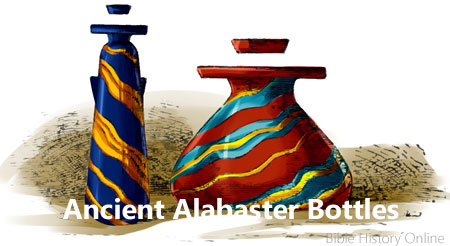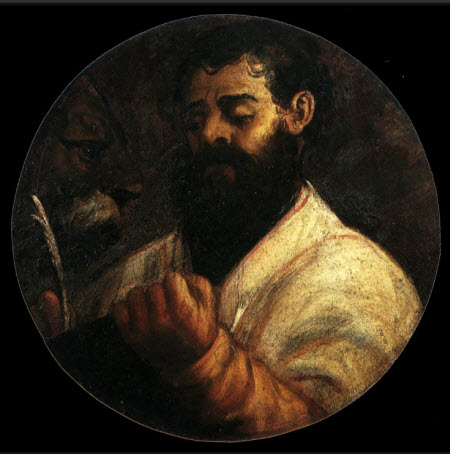Mr 14:53-72. JESUS ARRAIGNED BEFORE THE SANHEDRIM, CONDEMNED TO DIE, AND SHAMEFULLY ENTREATED--THE FALL OF PETER. ( = Mt 26:57-75; Lu 22:54-71; Joh 18:13-18, 24-27).
Had we only the first three Gospels, we should have concluded that our Lord was led immediately to Caiaphas, and had before the Council. But as the Sanhedrim could hardly have been brought together at the dead hour of night--by which time our Lord was in the hands of the officers sent to take Him--and as it was only "as soon as it was day" that the Council met (Lu 22:66), we should have had some difficulty in knowing what was done with Him during those intervening hours. In the Fourth Gospel, however, all this is cleared up, and a very important addition to our information is made (Joh 18:13, 14, 19-24). Let us endeavor to trace the events in the true order of succession, and in the detail supplied by a comparison of all the four streams of text.
Jesus Is Brought Privately before Annas, the Father-in-Law of Caiaphas (Joh 18:13, 14).
Joh 18:13:
And they led Him away to Annas first; for he was father-in-law to Caiaphas, which was the high priest that same year--This successful Annas, as ELLICOTT remarks, was appointed high priest by Quirinus, A.D. 12, and after holding the office for several years, was deposed by Valerius Gratius, Pilate's predecessor in the procuratorship of Judea [JOSEPHUS, Antiquities, 18.2.1, &c.]. He appears, however, to have possessed vast influence, having obtained the high priesthood, not only for his son Eleazar, and his son-in-law Caiaphas, but subsequently for four other sons, under the last of whom James, the brother of our Lord, was put to death [Antiquities, 20.9.1]. It is thus highly probable that, besides having the title of "high priest" merely as one who had filled the office, he to a great degree retained the powers he had formerly exercised, and came to be regarded practically as a kind of rightful high priest.Joh 18:14:
Now Caiaphas was he which gave counsel to the Jews, that it was expedient that one man should die for the people. See on Joh 11:51. What passed between Annas and our Lord during this interval the beloved disciple reserves till he has related the beginning of Peter's fall. To this, then, as recorded by our own Evangelist, let us meanwhile listen.
Peter Obtains Access within the Quadrangle of the High Priest's Residence, and Warms Himself at the Fire (Mr 14:53, 54).
53. And they led Jesus away to the high priest: and with him were
assembled--or rather, "there gathered together unto him."
all the chief priests and the elders and the scribes--it was then a
full and formal meeting of the Sanhedrim. Now, as the first three
Evangelists place all Peter's denials of his Lord after this, we should
naturally conclude that they took place
while our Lord stood before the Sanhedrim. But besides that the
natural impression is that the scene around the fire took place
overnight, the second crowing of the cock, if we are to credit
ancient writers, would occur about the beginning of the fourth watch, or
between three and four in the morning. By that time, however, the
Council had probably convened, being warned, perhaps, that they were to
prepare for being called at any hour of the morning, should the Prisoner
be successfully secured. If this be correct, it is fairly certain that
only the last of Peter's three denials would take place while our
Lord was under trial before the Sanhedrim. One thing more may require
explanation. If our Lord had to be transferred from the residence of
Annas to that of Caiaphas, one is apt to wonder that there is no mention
of His being marched from the one to the other. But the building, in all
likelihood, was one and the same; in which case He would merely have to
be taken perhaps across the court, from one chamber to another.
JFB.
Brief Summary: Christ anointed at Bethany. (1-11) The Passover, Jesus declares that Judas would betray him. (12-21) The Lord's supper instituted. (22-31) Christ's agony in the garden. (32-42) He is betrayed and taken. (43-52) Christ before the high priest. (53-65) Peter denies Christ. (66-72)

Alabaster bottles from the ancient
world
Mark 14:3 - And being in Bethany in the house of Simon the leper, as he sat at meat, there came a woman having an alabaster box of ointment of spikenard very precious; and she brake the box, and poured [it] on his head.
The Book of Mark
Mark 1:15 - And saying, The time is fulfilled, and the kingdom of God is at hand: repent ye, and believe the gospel.
Mark 2:12 - And immediately he arose, took up the bed, and went forth before them all; insomuch that they were all amazed, and glorified God, saying, We never saw it on this fashion.
Mark in The New Testament - A Brief Overview

Painting of St. Mark by Titian - 1560
Introduction to The Gospel of Mark
The Word Gospel. The second book of the English Bible that most of us read from is the Gospel of Mark. Mark is the second of the four gospel writings, yet there is only one gospel about Jesus Christ and there are four different writers: Matthew, Mark, Luke, and John. The word "Gospel" means "good news", and the good news is about Jesus Christ dying on the cross and then 3 days later conquering death and rising from the dead, offering salvation to all mankind, this is the Gospel.
Summary of The Book of Mark
Brief Summary. Jesus of Nazareth is the suffering servant who came to die for the sins of all men. He did His work and "immediately" went to the cross, so be encouraged all who are suffering because Christ suffered for you.
Purpose. The Book of Mark is the shortest of the 4 Gospel accounts of the life of Jesus Christ. and he seems to write his account of the Gospel of Christ with a sense of urgency. He mentions the word "immediately" 27 times. In Mark many times Jesus exercises actions rather than words, which would impress his Roman readers who the Book seems to be addressing. He portrays Jesus as a man of power and miracles, who could set aside the laws of nature at will. Yet this powerful Son of God was the suffering servant who would give up His life as a ransom for all mankind (Mark 10:45). The clear purpose of mark was to encourage those suffering persecution that their master suffered first, and He suffered for them.
Audience. Apparently Mark wrote his Gospel account to encourage gentile Christians in Rome who were facing the persecutions of the Emperor Nero. History is clear about the atrocious behavior of the Romans and especially the insanity of Nero. The other evidence that scholars bring up concerning mark's audience as being gentiles is the fact that Mark does not deal with Jewish Laws and he only quotes one prophecy from the Old Testament. There is also careful thought into explaining Jewish customs and idioms. (See Mark 3:7; 5:41; 7:2; 10:46; 14:36; 15:34; 9:43; 14:12; 15:42).
Authorship. The gospel of Mark does not proclaim who the author is within the document, yet the information that we know about Mark can be seen in the writer of this gospel. It is evident that the writer was Jewish, he was a Christian, and he was familiar with every day Jewish life, as well as the Jewish Scriptures. We know from the Scriptures that Mark was Jewish, and he knew the teachings of Jesus very well. He also knew the teachings of the rest of the apostles. It is also important to notice that after Peter was imprisoned he went to the house of Mary, the mother of Mark (Acts 12:12-17). Also Peter mentions in his epistle "my son Mark" (1 Peter 5:13). During Paul's missionary journeys Mark became a companion of Paul and Barnabas, and he left them at Perga in Pamphylia (Acts 13:13), after Paul had rebuked him. Many years later Mark regained the favor of Paul (Col. 4:10; 2 Tim. 4:11). Early Church tradition unanimously ascribes the second gospel to Mark as a companion of Peter and the writer of the second Gospel. One prologue to the Gospels which was written around 160 AD has this statement: "Mark� Was Peter's interpreter, and after Peter's decease wrote down this gospel in the region of Italy." Irenaeus, Clement of Alexandria and Tertullian also attest to Mark as the author.
Location. Nothing in the Gospel of Mark indicates where it was written from. Most of the early writers who boast of Mark as the author also name Rome as the place it was written.
Date. Early Christian writers and traditions place the Gospel of Mark sometime close to the end of Peter's life, around 60-65 AD. Most scholars agree that the Gospel of Mark was written before the destruction of Jerusalem in 70 AD, while the Second Temple in Jerusalem was still standing (Mark 13:1-2). Many scholars do not believe in the miracle of predictive prophecy and argue that the Gospel of Mark was written after the fall of Jerusalem, because of the accurate details of the events that Jesus spoke about. Mark's Gospel account seems to have been written as encouragement to the Christians who were facing the persecution of the Emperor Nero which took place in 64 AD.
Outline of the Book of Mark
The Servant Comes - Chapter 1:1-13
The Servant's Work - Chapters 1:14-13:37
The Servant's Death - Chapters 14:1-15:47
The Servant's Resurrection - Chapter 16:1-20

The Name Jesus In Ancient Hebrew Text
"Yeshua" in First Century Hebrew Text. This is how the name "Jesus"
would have been written in ancient Hebrew documents. The four letters or
consonants from right to left are Yod, Shin, Vav, Ayin (Y, SH, OO, A).
Jesus is the Greek name for the Hebrew name Joshua or Y'shua which means
"The LORD or Yahweh is Salvation".
Mark Resources
Outline of the Life of Jesus in Harmony
Simple Map of First Century Israel
Topographical Map of First Century Israel
Map of the Ministry of
Jesus
Map of the Roads in Ancient Israel
Map of the Roman Empire